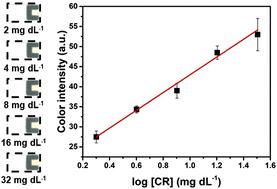Our official English website, www.x-mol.net, welcomes your
feedback! (Note: you will need to create a separate account there.)
Integration of paper-based analytical devices with digital microfluidics for colorimetric detection of creatinine
Analyst ( IF 3.6 ) Pub Date : 2024-10-08 , DOI: 10.1039/d4an00688g Larissa G. Velasco, Danielly S. Rocha, Richard P. S. de Campos, Wendell K. T. Coltro
Analyst ( IF 3.6 ) Pub Date : 2024-10-08 , DOI: 10.1039/d4an00688g Larissa G. Velasco, Danielly S. Rocha, Richard P. S. de Campos, Wendell K. T. Coltro

|
Digital microfluidics (DMF) is a platform that enables the automated manipulation of individual droplets of sizes ranging from nanoliter to microliter and can be coupled with numerous techniques, including colorimetry. However, although the DMF electrode architecture is highly versatile, its integration with different analytical methods often requires either changes in sample access, top plate design, or the integration of supplementary equipment into the system. As an alternative to overcome these challenges, this study proposes a simple integration between paper-based analytical devices (PADs) and DMF for automated and eco-friendly sample processing aiming at the colorimetric detection of creatinine (CR, an important biomarker for kidney disease) in artificial urine. An optimized and selective Jaffé reaction was performed on the device, and the reaction products were delivered to the PAD, which was subsequently analyzed with a bench scanner. The optimal operational parameters on the DMF platform were a reaction time of 45 s with circular mixing and image capture after 5 min. Under optimized conditions, a linear behavior was obtained for creatinine concentrations ranging from 2 to 32 mg dL−1, with limits of detection and quantitation equal to 1.4 mg dL−1 and 2.0 mg dL−1, respectively. For the concentration range tested, the relative standard deviation varied from 2.5 to 11.0%, considering four measurements per concentration. CR-spiked synthetic urine samples were subjected to analysis via DMF-PAD and the spectrophotometric reference method. The concentrations of CR determined using both analytical techniques were close to the theoretical values, with the resultant standard deviations of 2–9% and 1–4% for DMF-PADs and spectrophotometry, respectively. Furthermore, the recovery values were within the acceptable range, with DMF-PADs yielding 96–108% and spectrophotometry producing 95–102%. Finally, the greenness of the DMF-PAD and spectrophotometry methods was evaluated using the Analytical Greenness (AGREE) metric software, in which 0.71 and 0.51 scores were obtained, respectively. This indicates that the proposed method presents a higher greenness level, mainly due to its miniaturized characteristics using a smaller volume of reagent and sample and the possibility of automation, thus reducing user exposure to potentially toxic substances. Therefore, the DMF-PADs demonstrated great potential for application in the clinical analysis of creatinine, aiding in routine tests by introducing an automated, simple, and environmentally friendly process.
中文翻译:

将纸质分析设备与数字微流体技术集成,用于肌酐的比色检测
数字微流体 (DMF) 是一个平台,能够自动处理从纳升到微升大小的单个液滴,并且可以与多种技术相结合,包括比色法。然而,尽管 DMF 电极结构具有高度的通用性,但它与不同分析方法的集成通常需要更改样品通道、顶板设计或将辅助设备集成到系统中。作为克服这些挑战的替代方案,本研究提出了纸基分析设备 (PAD) 和 DMF 之间的简单集成,以实现自动化和环保的样品处理,旨在比色检测人工尿液中的肌酐(CR,肾脏疾病的重要生物标志物)。在设备上进行优化的选择性 Jaffé 反应,反应产物被输送到 PAD,随后用台式扫描仪进行分析。DMF 平台上的最佳操作参数为 45 s 的反应时间,循环混合和 5 min 后的图像捕获。在优化条件下,肌酐浓度范围为 2 至 32 mg dL-1,检测限和定量限分别为 1.4 mg dL-1 和 2.0 mg dL-1。对于测试的浓度范围,考虑到每种浓度进行四次测量,相对标准偏差在 2.5% 到 11.0% 之间变化。通过 DMF-PAD 和分光光度法参比方法对 CR 加标合成尿液样品进行分析。 使用两种分析技术测定的 CR 浓度接近理论值,DMF-PAD 和分光光度法的所得标准偏差分别为 2-9% 和 1-4%。此外,回收率值在可接受的范围内,DMF-PADs 的产量为 96-108%,分光光度法的产量为 95-102%。最后,使用分析绿色度 (AGREE) 度量软件评估 DMF-PAD 和分光光度法的绿色度,分别获得 0.71 和 0.51 分。这表明所提出的方法呈现出更高的绿色度水平,主要是由于其使用较小体积的试剂和样品的小型化特性以及自动化的可能性,从而减少了用户对潜在有毒物质的暴露。因此,DMF-PAD 在肌酐临床分析中显示出巨大的应用潜力,通过引入自动化、简单且环保的流程来帮助常规测试。
更新日期:2024-10-08
中文翻译:

将纸质分析设备与数字微流体技术集成,用于肌酐的比色检测
数字微流体 (DMF) 是一个平台,能够自动处理从纳升到微升大小的单个液滴,并且可以与多种技术相结合,包括比色法。然而,尽管 DMF 电极结构具有高度的通用性,但它与不同分析方法的集成通常需要更改样品通道、顶板设计或将辅助设备集成到系统中。作为克服这些挑战的替代方案,本研究提出了纸基分析设备 (PAD) 和 DMF 之间的简单集成,以实现自动化和环保的样品处理,旨在比色检测人工尿液中的肌酐(CR,肾脏疾病的重要生物标志物)。在设备上进行优化的选择性 Jaffé 反应,反应产物被输送到 PAD,随后用台式扫描仪进行分析。DMF 平台上的最佳操作参数为 45 s 的反应时间,循环混合和 5 min 后的图像捕获。在优化条件下,肌酐浓度范围为 2 至 32 mg dL-1,检测限和定量限分别为 1.4 mg dL-1 和 2.0 mg dL-1。对于测试的浓度范围,考虑到每种浓度进行四次测量,相对标准偏差在 2.5% 到 11.0% 之间变化。通过 DMF-PAD 和分光光度法参比方法对 CR 加标合成尿液样品进行分析。 使用两种分析技术测定的 CR 浓度接近理论值,DMF-PAD 和分光光度法的所得标准偏差分别为 2-9% 和 1-4%。此外,回收率值在可接受的范围内,DMF-PADs 的产量为 96-108%,分光光度法的产量为 95-102%。最后,使用分析绿色度 (AGREE) 度量软件评估 DMF-PAD 和分光光度法的绿色度,分别获得 0.71 和 0.51 分。这表明所提出的方法呈现出更高的绿色度水平,主要是由于其使用较小体积的试剂和样品的小型化特性以及自动化的可能性,从而减少了用户对潜在有毒物质的暴露。因此,DMF-PAD 在肌酐临床分析中显示出巨大的应用潜力,通过引入自动化、简单且环保的流程来帮助常规测试。


















































 京公网安备 11010802027423号
京公网安备 11010802027423号